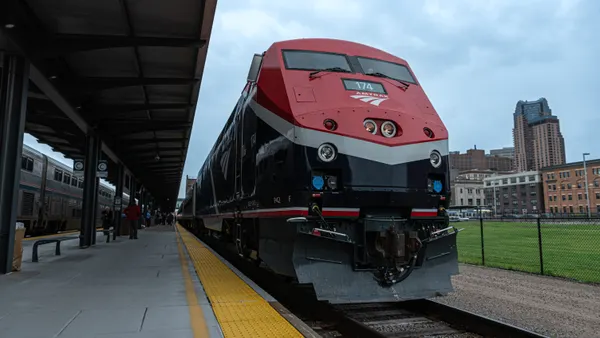Correction: We have corrected the headline for this story, which contained an erroneous implication about U.S. transit ridership growth.
Dive Brief:
- Transit ridership in the U.S. rose to more than 70% of pre-COVID-19 pandemic levels in September, the American Public Transportation Association said Wednesday.
- People took nearly 147 million trips on public transit between Sept. 18 and Sept. 24, according to APTA’s Ridership Trends Dashboard — a dramatic change from April 2020, when most people stopped using public transit, and ridership fell below 20% of pre-pandemic levels nationwide.
- Many public transit systems are struggling financially because they are not collecting enough fare revenue from passengers. Riders have returned slowly, making it difficult for local governments to deal with rising costs, worker shortages and aging infrastructure. In turn, growing ridership could help public transit agencies address their financial problems and avoid service cuts or fare increases.
Dive Insight:
APTA President and CEO Paul Skoutelas said in a news release that “as we see more workers return to the office, more students return to school, and more community destinations such as restaurants, theaters, and retail stores reopen their doors, agencies from coast-to-coast are seeing a rise in ridership.”
Federal COVID-19 relief funds have allowed public transit agencies to continue providing service since the pandemic began, but the money is quickly running out. Most agencies will spend all their COVID-19 funding by January 2024, according to APTA.
In July, New York’s state comptroller warned that the Metropolitan Transportation Authority — the largest public transit agency in the U.S. — will face increasing budget deficits beginning in 2025.
“Unless there is an additional influx of city, state or federal aid, the MTA is facing stark options for closing its budget gaps that will impact riders,” State Comptroller Thomas DiNapoli said in a July news release. “The MTA needs to lay out what is at stake and explain to the public what options it’s considering to close budget gaps and how it can adjust to continued low ridership levels and shift service to meet changes in demand.”
Transit officials nationwide are considering several options to address the financial troubles: cutting service to meet demand, reducing staffing or maintenance, lowering capital spending, hiking fares or increasing service where and when ridership is highest.
To address equity concerns, some transit systems have reduced or eliminated fares for all riders or specific groups, such as youths, older people, or people with low incomes. But lower ridership strains transit revenues, possibly limiting an agency’s ability to continue low- or zero-fare programs.
Cities are also building mixed-use developments near public transportation to encourage transit use in a bid to increase housing supply while minimizing pollution from transportation. They are also trying to address rising violent crime on buses and trains, which is deterring some people from returning to public transportation.













